From today's Washington Post:
"Corpus takes visitors inside a large-scale human body with interactive, multi-sensory exhibits that reveal how it operates. Visitors enter the museum through the knee, then travel through eight exhibit spaces, heading up toward the brain. On the way, they can watch a 3-D film on fertilization, bounce on a rubber tongue while they follow a sandwich being digested and throw beanbags against a video screen to destroy bacteria."
They're talking about Corpus, a museum in Amsterdam, The Netherlands. And I would be adding this to my itinerary, for sure, if I were visiting the EU anytime soon. I would expect that others in the Museum are familiar with this cousin (?) of ours from abroad. Maybe they might elaborate further in comments.
An unofficial blog about the National Museum of Health and Medicine (nee the Army Medical Museum) in Silver Spring, MD. Visit for news about the museum, new projects, musing on the history of medicine and neat pictures.
Tuesday, April 8, 2008
Cell-sorting tech
Here's a story about recent biomedical history - "From the World of Modern Cell Science, A Long and Sorted Coming-of-Age Story, by David Brown, Washington Post Staff Writer, Monday, April 7, 2008; A06. For years, in our AIDS exhibit, we had displayed a Fluorescent Activated Cell Sorter on loan from the Smithsonian. I imagine it's the same piece mentioned in this article. In this online discussion, "Science and Medicine: Cell Technology," by David Brown and J. Paul Robinson, Washington Post Staff Writer and Professor, Purdue University, Tuesday, April 8, 2008; 11:00 AM, one can find a comment from the Medical Sciences curator Ray Kondratas who led the division at the Museum of American History for many years.
Sunday, April 6, 2008
Adler Museum of Medicine in South Africa
Last week, we received the new issue of the Adler Museum of Medicine's Bulletin, which has articles on the Museum and South African medical history. It's a nice glossy publication and you can subscribe to it from their website. We send them our publication, Flesh and Bones, in exchange - it's a newsletter, not a journal, but comes out slightly more often.
the week on flickr - Korean war body armor, Civil War and mosquitoes
April 4th:
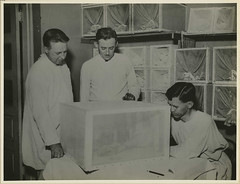
Emergency encephalitis laboratory. Jefferson Barracks, Missouri. (Major Cornell, Simmons and Sergeant Rhodes.) [The volunteer has put his arm in a screened cage to be bitten by mosquitoes. Scene. Laboratories. Military camps.]
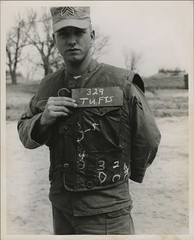
Armored Vest Number 329 worn by Private 1st Class Willie Tufts, US 52077771, with bullet holes circled and marked 1, 2, 3, 4, and 5. Company E, 7th Regiment. Front view. 04/26/1952. [Korean War]
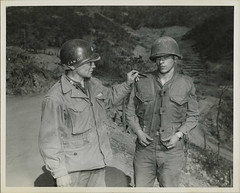
Captain Robert Bessey, Jr. (Cincinnati, OH), Infantry member of the Body Armor Team I, Company 15, Infantry Regiment, 30 Division, points to fragment hole in vest worn by Private Edward Schallack (4905 N. 36 St., Milwaukee, WI) who wore the vest on patrol. 04/24/1952. [Korean War]
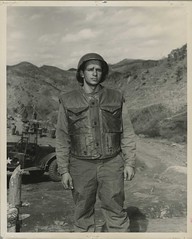
Private 1st Class Leo Curran, Jr., 46 1/2 Allen Street, Hudson, NY. E Company, 7th Regiment, 3rd Division. Was hit in back with fragment while wearing body armor vest on patrol. No penetration. 04/18/1952. [Korean War]
April 1st:
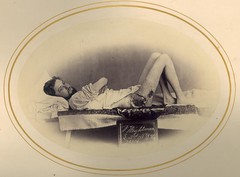
"Gunshot wound of hip." Private William W. Wrightman, Co. L, 2nd New York Heavy Artillery. Wounded at Petersburg, VA on March 31, 1865. Treated by Reed Bontecou at Harewood Hospital.[Civil War]

Emergency encephalitis laboratory. Jefferson Barracks, Missouri. (Major Cornell, Simmons and Sergeant Rhodes.) [The volunteer has put his arm in a screened cage to be bitten by mosquitoes. Scene. Laboratories. Military camps.]

Armored Vest Number 329 worn by Private 1st Class Willie Tufts, US 52077771, with bullet holes circled and marked 1, 2, 3, 4, and 5. Company E, 7th Regiment. Front view. 04/26/1952. [Korean War]

Captain Robert Bessey, Jr. (Cincinnati, OH), Infantry member of the Body Armor Team I, Company 15, Infantry Regiment, 30 Division, points to fragment hole in vest worn by Private Edward Schallack (4905 N. 36 St., Milwaukee, WI) who wore the vest on patrol. 04/24/1952. [Korean War]

Private 1st Class Leo Curran, Jr., 46 1/2 Allen Street, Hudson, NY. E Company, 7th Regiment, 3rd Division. Was hit in back with fragment while wearing body armor vest on patrol. No penetration. 04/18/1952. [Korean War]
April 1st:

"Gunshot wound of hip." Private William W. Wrightman, Co. L, 2nd New York Heavy Artillery. Wounded at Petersburg, VA on March 31, 1865. Treated by Reed Bontecou at Harewood Hospital.[Civil War]
Saturday, April 5, 2008
Unexpected consequences in universal health care
Apparently there aren't enough doctors doing primary care in Massachusetts to take care of all the newly-insured. This has got to be one of the stupider reasons for not being able to get a physical this year, but it probably was unpredictable. See the article for the details.
In Massachusetts, Universal Coverage Strains Care
By KEVIN SACK
New York Times April 5, 2008
An influx of newly insured patients is widening the gap between the supply of primary care physicians and the demand for their services.
In Massachusetts, Universal Coverage Strains Care
By KEVIN SACK
New York Times April 5, 2008
An influx of newly insured patients is widening the gap between the supply of primary care physicians and the demand for their services.
Friday, April 4, 2008
Brain Awareness Week mascot; OR, you can go home again if you squint
Former museum graphics guy Bill Discher wrote in to point out that the Brain Awareness Week mascot, seen here...

didn't quite look the way Bill remembered leaving him when he moved on last fall...

...so Bill reworked him again for this look...

..and since he cared enough to do this and write in, you can all see that Museums design by committee at times.

didn't quite look the way Bill remembered leaving him when he moved on last fall...

...so Bill reworked him again for this look...

..and since he cared enough to do this and write in, you can all see that Museums design by committee at times.
Thursday, April 3, 2008
Stop What You Are Doing. Watch This Video.
They had me at 'writhing.' Visit Medgadget first, because they are awesome, and then click through to the New England Journal of Medicine. Hopefully, you too will have the pleasure of watching this video. (Meaning, hopefully this week's feature will prove so popular that NEJM will leave it available to non-subscribers forever.)
I know I won't be alone in saying, I want one of those for our collection!
I know I won't be alone in saying, I want one of those for our collection!
A few more "Triumph at Carville" links
Mike made an earlier mention of our new temporary exhibition "Triumph at Carville: A Tale of Leprosy in America." The exhibit is closely linked to a documentary of the same name, which premiered on PBS last week (check local listings.) We issued a brief news release about the new exhibit, and and while we work on an online component of the Carville exhibit, I thought I would link to a few positive reviews of the film. Terre Haute's Tribune Star offered this positive review, and the Times-Picayune called the film 'troubling, challenging, beautiful.' I would agree, now having seen the film several times: it's a powerful story, lovingly told by the filmmakers.
I want to offer, a link to the good people at the National Hansen's Disease Program in Baton Rouge, and the National Hansen's Disease Museum in Carville. Their assistance was invaluable in preparing this exhibit, and we appreciate their taking time from their work to partner with us to tell this story.
And I'll mention one correction to the Tribune-Star story: we're always glad for a newspaper mention, but to be certain there's no confusion: the Museum is in upper northwest Washington, D.C., and not in Bethesda, MD.
View Larger Map
I want to offer, a link to the good people at the National Hansen's Disease Program in Baton Rouge, and the National Hansen's Disease Museum in Carville. Their assistance was invaluable in preparing this exhibit, and we appreciate their taking time from their work to partner with us to tell this story.
And I'll mention one correction to the Tribune-Star story: we're always glad for a newspaper mention, but to be certain there's no confusion: the Museum is in upper northwest Washington, D.C., and not in Bethesda, MD.
View Larger Map
Body armor article noted in passing
This article raised a few thoughts about the Museum and the Pathology Institute - "Contracts for Body Armor Filled Without Initial Tests: Inspections Skipped in 13 Of 28 Deals, Report Finds," By Dana Hedgpeth, Washington Post Staff Writer, Thursday, April 3, 2008; Page D01.
"Why?" you say.
Don't worry, we're not producing armor. However over the years, the AFIP has helped evaluate armor. We've got hundreds of pictures of used (unfortunately) body armor from the Korean War in the Archives, and several actual pieces on display now on the Museum floor. Also, the AFIP currently runs the Office of the Armed Forces Medical Examiner which is responsible for investigating military deaths and performs autopsies that can suggest the protection that the armor did or did not afford.
And we've got a really cool piece of armor from the Civil War that didn't work at all. It's got a bullet hole right through the breastplate. Whoops. (It's not on display now, but there is a photo of it in the lobby).
"Why?" you say.
Don't worry, we're not producing armor. However over the years, the AFIP has helped evaluate armor. We've got hundreds of pictures of used (unfortunately) body armor from the Korean War in the Archives, and several actual pieces on display now on the Museum floor. Also, the AFIP currently runs the Office of the Armed Forces Medical Examiner which is responsible for investigating military deaths and performs autopsies that can suggest the protection that the armor did or did not afford.
And we've got a really cool piece of armor from the Civil War that didn't work at all. It's got a bullet hole right through the breastplate. Whoops. (It's not on display now, but there is a photo of it in the lobby).
Stuff the museum should have
After fifteen years working in the bowels (well, maybe more like the small intestine) of the museum collections, one tends to developed a vision of things the museum should have. Jessics Joslin's half-animal steampunk creatures should be in one of those nice blue cabinets in the back room. As should Sarina Brewer's more classical taxidermy with a bit of a twist.
Copper, wonderful copper
Here's an interesting article on copper's disinfectant effects, and rediscovering them for germ control in hospitals - "Copper's mettle: It's a germ killer," By Shelley Widhalm, Washington Times, April 3, 2008. What an elegant idea - cheap, simple and hopefully effective.
Librarians Love Us
Gentle readers, a few links for you, and both by authors who stem from one of my favorite professions: librarians!
A very neat blog named Folderol: A Spooky Librarians Production linked to this very blog, and even graced us with our finest compliment to date: "best title ever..." Thanks, Folderol, for the link, and come back anytime.
And from very close to home, a librarian with the vaunted Montgomery County Public Library system linked to this blog, and for that we say, thanks! She's very nice, too, calling this blog "charming" and all.
As someone who spent an untold number of hours using the MCPL (Rockville branch, old-school style, back in the day) as part-time babysitter and enabler of geek addictions as a wayward teen, I have a great fondness for librarians. Especially today, because as a purveyor of information in my chosen field, I am compelled to put on a pedestal someone whose expertise is in weighing and judging the quality of all sorts of information, and have that uncanny knack to find out anything about anything with alacrity. (Without librarians, how else would I even know how to find out what alacrity means?)
A very neat blog named Folderol: A Spooky Librarians Production linked to this very blog, and even graced us with our finest compliment to date: "best title ever..." Thanks, Folderol, for the link, and come back anytime.
And from very close to home, a librarian with the vaunted Montgomery County Public Library system linked to this blog, and for that we say, thanks! She's very nice, too, calling this blog "charming" and all.
As someone who spent an untold number of hours using the MCPL (Rockville branch, old-school style, back in the day) as part-time babysitter and enabler of geek addictions as a wayward teen, I have a great fondness for librarians. Especially today, because as a purveyor of information in my chosen field, I am compelled to put on a pedestal someone whose expertise is in weighing and judging the quality of all sorts of information, and have that uncanny knack to find out anything about anything with alacrity. (Without librarians, how else would I even know how to find out what alacrity means?)
Dillinger - the FAQ
Our former PR man Steven Solomon sent me a note this morning with a link to this story - Dillinger: The man, the myths. Steven spent a lot of time on creating little pages in a FAQ to explain parts of the museum including No. 43 - Do you have 20th-century gangster John Dillinger's penis in the collection?
Want to help in a human dissection?
Ever wanted to model yourself after Leonardo?
Here's the final notice from a program in Indiana.
**** F I N A L N O T I C E *****
APPLICATION DEADLINE: *** MAY 1, 2008 ***
***** NATIONAL HUMAN CADAVER PROSECTION PROGRAM *****
Indiana University School of Medicine-Northwest Dunes Medical Professional Building 3400 Broadway Gary, Indiana University
PROGRAM SPONSOR: ZIMMER, Inc. (Zimmer Orthopedics)
**** Human Cadaver Dissection **** **** Radiology **** **** Orthopedic Surgery Demonstrations ****
Applications for the July 2008, NATIONAL Human Cadaver Prosection Program at the Indiana University School of Medicine-Northwest(IUSM-NW) are now being accepted. The application form is available online at the IUSM-NW Web Site (URL: http://iusm-nw.medicine.iu.edu). The Cadaver Prosection page is linked to the IUSM-NW front page. [Click on "IUSM-Northwest Educational Programs, and then "Cadaver Prosection"]
The Cadaver Prosection will be held on Wednesday, July 30 and Thursday, July 31, 2008, from 8:00 a.m. - 5:00 p.m., and will include 2 evenings of preparatory work in late June.
Selected participants who complete the program will receive a certificate of completion, honorarium and certification for work with biohazards and blood-borne pathogens. All will have extensive hands-on experience professionally dissecting human cadavers, and will receive intensive exposure to human gross anatomy and radiology.
Zimmer Orthopedics will conduct a special lecture presentation and accepted applicants will participate in a hands-on orthopedic workshop. CME Credit is offered for the NATIONAL Human Cadaver Prosection Program.
You need not be a medical professional or pre-medical student to participate. All are encouraged to apply. Prior participants have included pre-med and pre-vet, nursing, radiological technology, mortuary science students, other undergraduate and graduate students, teachers, attorneys, lab technicians, etc.
For further information go to the Cadaver Prosection Page, or contact the program director:
Ernest F. Talarico, Jr., Ph.D.
TEL: 219-981-4356
Email: etalaric@iun.edu
Send (ordinary mail or email) your application materials to:
Ernest F. Talarico, Jr., Ph.D.
Assistant Director of Medical Education
Indiana University School of Medicine - Northwest Campus Dunes Medical
Professional Building Room 3028A 3400 Broadway Gary, IN 46408
Here's the final notice from a program in Indiana.
**** F I N A L N O T I C E *****
APPLICATION DEADLINE: *** MAY 1, 2008 ***
***** NATIONAL HUMAN CADAVER PROSECTION PROGRAM *****
Indiana University School of Medicine-Northwest Dunes Medical Professional Building 3400 Broadway Gary, Indiana University
PROGRAM SPONSOR: ZIMMER, Inc. (Zimmer Orthopedics)
**** Human Cadaver Dissection **** **** Radiology **** **** Orthopedic Surgery Demonstrations ****
Applications for the July 2008, NATIONAL Human Cadaver Prosection Program at the Indiana University School of Medicine-Northwest(IUSM-NW) are now being accepted. The application form is available online at the IUSM-NW Web Site (URL: http://iusm-nw.medicine.iu.edu). The Cadaver Prosection page is linked to the IUSM-NW front page. [Click on "IUSM-Northwest Educational Programs, and then "Cadaver Prosection"]
The Cadaver Prosection will be held on Wednesday, July 30 and Thursday, July 31, 2008, from 8:00 a.m. - 5:00 p.m., and will include 2 evenings of preparatory work in late June.
Selected participants who complete the program will receive a certificate of completion, honorarium and certification for work with biohazards and blood-borne pathogens. All will have extensive hands-on experience professionally dissecting human cadavers, and will receive intensive exposure to human gross anatomy and radiology.
Zimmer Orthopedics will conduct a special lecture presentation and accepted applicants will participate in a hands-on orthopedic workshop. CME Credit is offered for the NATIONAL Human Cadaver Prosection Program.
You need not be a medical professional or pre-medical student to participate. All are encouraged to apply. Prior participants have included pre-med and pre-vet, nursing, radiological technology, mortuary science students, other undergraduate and graduate students, teachers, attorneys, lab technicians, etc.
For further information go to the Cadaver Prosection Page, or contact the program director:
Ernest F. Talarico, Jr., Ph.D.
TEL: 219-981-4356
Email: etalaric@iun.edu
Send (ordinary mail or email) your application materials to:
Ernest F. Talarico, Jr., Ph.D.
Assistant Director of Medical Education
Indiana University School of Medicine - Northwest Campus Dunes Medical
Professional Building Room 3028A 3400 Broadway Gary, IN 46408
Wednesday, April 2, 2008
A pre-Revolutionary War doctor re-enactor
Last weekend I was down at George Mason's home Gunston Hall where Doctor Henry Payne was explaining how he treated patients in 1764. Fortunately my camera technology still worked and I captured his image. It's been many a year since we've had a reenactor program at the museum... maybe, maybe...

Doctor Henry Payne (aka Doug Cohen) demonstrating bleeding at at George Mason's house Gunston Hall.
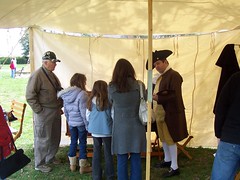
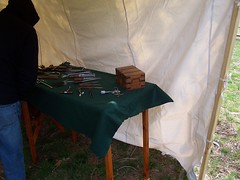
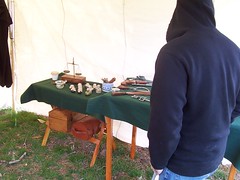

Doctor Henry Payne (aka Doug Cohen) demonstrating bleeding at at George Mason's house Gunston Hall.



Exciting new book by one of our collaborators
Our colleagues at the Borden Institute on Walter Reed AMC recently came out with a new book. We didn't help on this one, but we are collaborating on an illustrated history of Walter Reed AMC. I was speaking to a friend who's an historian of medicine today and he was marveling at how much historical information needed to be included in this volume.
Book Explores Medical Aspects of Biological Warfare
BORDEN INSTITUTE RELEASES MEDICAL ASPECTS OF BIOLOGICAL WARFARE
Washington, DC - Reflecting the critical threat posed by biological warfare and terrorism, the Borden Institute has released Medical Aspects of Biological Warfare, the latest volume in the Textbooks of Military Medicine series.
This book is an update of the previous edition of Medical Aspects of Chemical and Biological Warfare, published in 1997. "The need for a revised version of this work has never been greater. A decade later, the complexity of the threat has increased beyond the boundaries of state-sponsored programs and to the terrorist use of novel pathogens," according to Colonel George W. Korch, MS, US Army, Commander, US Army
Medical Research Institute of Infectious Diseases. "The continued threat of biological weapons dictates that all Department of Defense medical personnel become conversant with state-of-the-art treatment for biological casualties. What may have been perceived merely as useful information in the past is now a requirement for all medical providers."
Major General Gale S. Pollock, while serving as the acting surgeon general, recently said that "we must counter this threat with vigilance and maximize our response to attack with our best medical practices to identify agents involved, minimize casualties, and expedite the treatment of survivors."
Grounded in a historical perspective, Medical Aspects of Biological Warfare addresses weaponization of biological agents, categorizing potential agents as food, waterborne, or agricultural agents or toxins, and discusses their respective epidemiology. Descriptions of individual agents and the illnesses induced include recent advances in biomedical knowledge. The authors present familiar (anthrax, plague, smallpox) and less often discussed (alphaviruses, staphylococcal enterotoxins) biotoxins and explain methods for early agent identification. To
maximize understanding, authors present case studies and research on successful management practices, treatments, and antidotes.
Topics covered by the book include the history of biological weapons; food, waterborne, and agricultural diseases; epidemiology of biowarfare and bioterrorism; organisms and toxins; laboratory identification; consequence management; medical management of biological casualties; countermeasures; biosafety; ethical and legal considerations in biodefense research; and emerging infectious diseases.
Conceived in 1987, the Borden Institute, under the Army Surgeon General, publishes the Textbooks of Military Medicine. Each book is a comprehensive subject reference on the art and science of military medicine, extensively illustrated, and written to integrate lessons learned in past wars with current principles and practices of military medicine.
The Borden Institute offers volumes in hardback, as well as on its website and on CD-ROM.
For more information on the Borden Institute and how to order the publications, visit the organization online at www.bordeninstitute.army.mil.
FOR IMMEDIATE RELEASE FOR MORE INFORMATION, CONTACT:
Ronald Wallace, 202-782-4329 or
ronald.wallace @na.amedd.army.mil
Book Explores Medical Aspects of Biological Warfare
BORDEN INSTITUTE RELEASES MEDICAL ASPECTS OF BIOLOGICAL WARFARE
Washington, DC - Reflecting the critical threat posed by biological warfare and terrorism, the Borden Institute has released Medical Aspects of Biological Warfare, the latest volume in the Textbooks of Military Medicine series.
This book is an update of the previous edition of Medical Aspects of Chemical and Biological Warfare, published in 1997. "The need for a revised version of this work has never been greater. A decade later, the complexity of the threat has increased beyond the boundaries of state-sponsored programs and to the terrorist use of novel pathogens," according to Colonel George W. Korch, MS, US Army, Commander, US Army
Medical Research Institute of Infectious Diseases. "The continued threat of biological weapons dictates that all Department of Defense medical personnel become conversant with state-of-the-art treatment for biological casualties. What may have been perceived merely as useful information in the past is now a requirement for all medical providers."
Major General Gale S. Pollock, while serving as the acting surgeon general, recently said that "we must counter this threat with vigilance and maximize our response to attack with our best medical practices to identify agents involved, minimize casualties, and expedite the treatment of survivors."
Grounded in a historical perspective, Medical Aspects of Biological Warfare addresses weaponization of biological agents, categorizing potential agents as food, waterborne, or agricultural agents or toxins, and discusses their respective epidemiology. Descriptions of individual agents and the illnesses induced include recent advances in biomedical knowledge. The authors present familiar (anthrax, plague, smallpox) and less often discussed (alphaviruses, staphylococcal enterotoxins) biotoxins and explain methods for early agent identification. To
maximize understanding, authors present case studies and research on successful management practices, treatments, and antidotes.
Topics covered by the book include the history of biological weapons; food, waterborne, and agricultural diseases; epidemiology of biowarfare and bioterrorism; organisms and toxins; laboratory identification; consequence management; medical management of biological casualties; countermeasures; biosafety; ethical and legal considerations in biodefense research; and emerging infectious diseases.
Conceived in 1987, the Borden Institute, under the Army Surgeon General, publishes the Textbooks of Military Medicine. Each book is a comprehensive subject reference on the art and science of military medicine, extensively illustrated, and written to integrate lessons learned in past wars with current principles and practices of military medicine.
The Borden Institute offers volumes in hardback, as well as on its website and on CD-ROM.
For more information on the Borden Institute and how to order the publications, visit the organization online at www.bordeninstitute.army.mil.
FOR IMMEDIATE RELEASE FOR MORE INFORMATION, CONTACT:
Ronald Wallace, 202-782-4329 or
ronald.wallace @na.amedd.army.mil
Tuesday, April 1, 2008
What's more dangerous? Driving or malaria?
C'mon it's a trick question. The answer is vaccination.
Nah. April Fool's!
The UN says driving. Their top 10 causes of death are [my comments]:
1. Ischemic heart disease
2. Cerebrovascular heart disease (such as stroke)
3. Lower respiratory infections (pneumonia)
4. HIV-AIDS
5. Chronic obstructive pulmonary disease
6. Perinatal conditions [that's pretty broad, isn't it?]
7. Diarrheal diseases [cholera! dysentery!]
8. Tuberculosis
9. Trachea, bronchus and lung cancers
10. Road traffic injuries
11. Diabetes
12. Malaria
Uh-huh. And what would worry most Americans? Probably being struck by lightening or flying or something.
Read an op-ed at An "Epidemic on Wheels," By Norman Y. Mineta, Washington Post Monday, March 31, 2008; Page A19
Nah. April Fool's!
The UN says driving. Their top 10 causes of death are [my comments]:
1. Ischemic heart disease
2. Cerebrovascular heart disease (such as stroke)
3. Lower respiratory infections (pneumonia)
4. HIV-AIDS
5. Chronic obstructive pulmonary disease
6. Perinatal conditions [that's pretty broad, isn't it?]
7. Diarrheal diseases [cholera! dysentery!]
8. Tuberculosis
9. Trachea, bronchus and lung cancers
10. Road traffic injuries
11. Diabetes
12. Malaria
Uh-huh. And what would worry most Americans? Probably being struck by lightening or flying or something.
Read an op-ed at An "Epidemic on Wheels," By Norman Y. Mineta, Washington Post Monday, March 31, 2008; Page A19
"Red (double) Cross"
The April issue of the Costco Connection magazine reports a scam that targets military families who have a family member on deployment. Someone who claims to be from the Red Cross calls the family and says they need personal information about the service member so paperwork for a hospital transfer can be completed. According to the article (Consumer Connection on page 11), the Red Cross never contacts military families this way. Given our connection with Walter Reed Army Medical Center, this strikes particularly close to home.
Another Civil War upload to the Internet Archive
Today we uploaded anther book to the Internet Archive, but instead of a text, this one is a photograph album. Given to Frances Pleasants by wounded soldiers she cared for during the Civil War in Germantown, Pennsylvania, it holds photographs, tintypes, and cartes-de-visite, as well as newspaper clippings.

Labels:
Civil War,
Otis Historical Archives,
photographs
Subscribe to:
Comments (Atom)